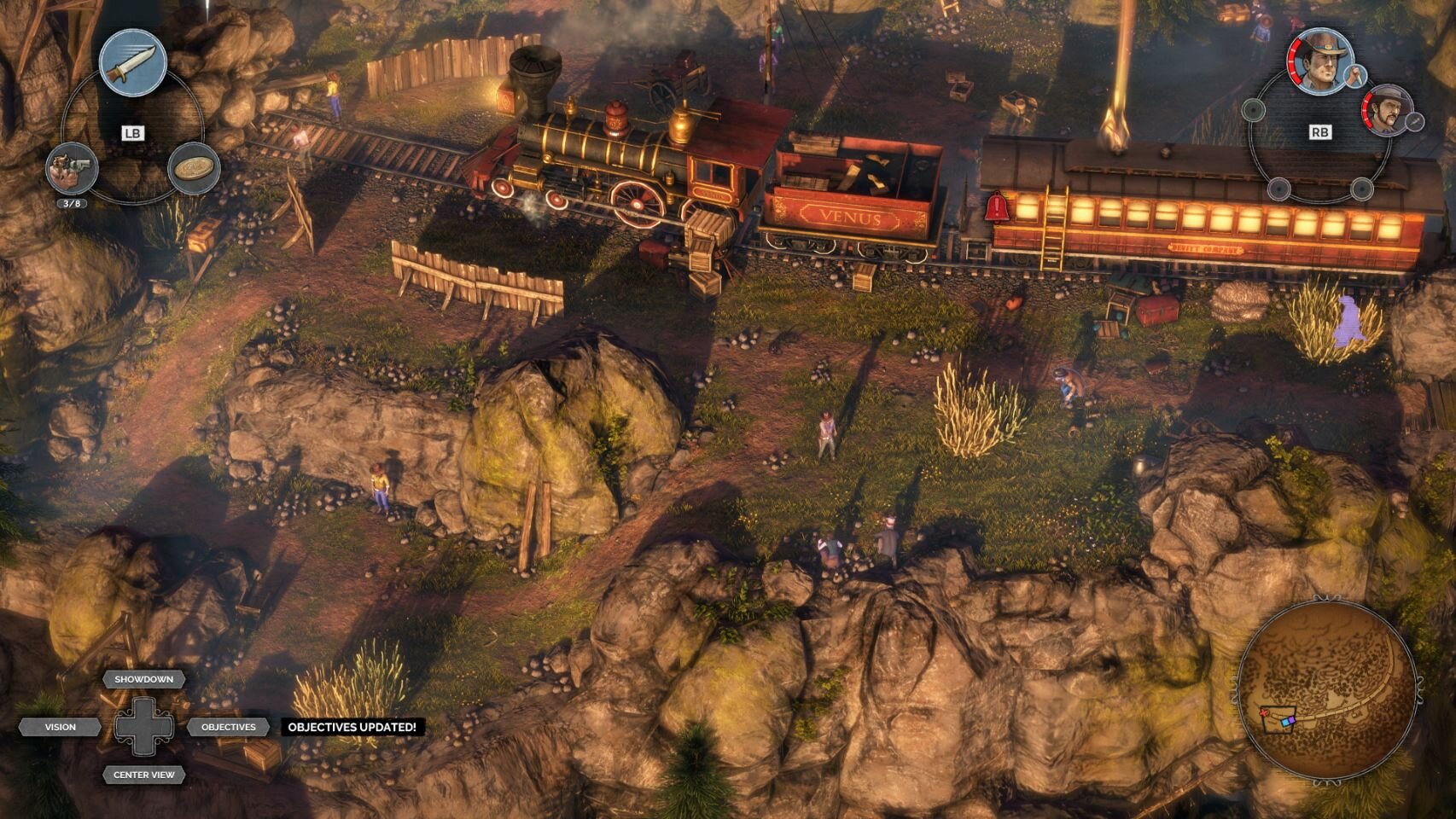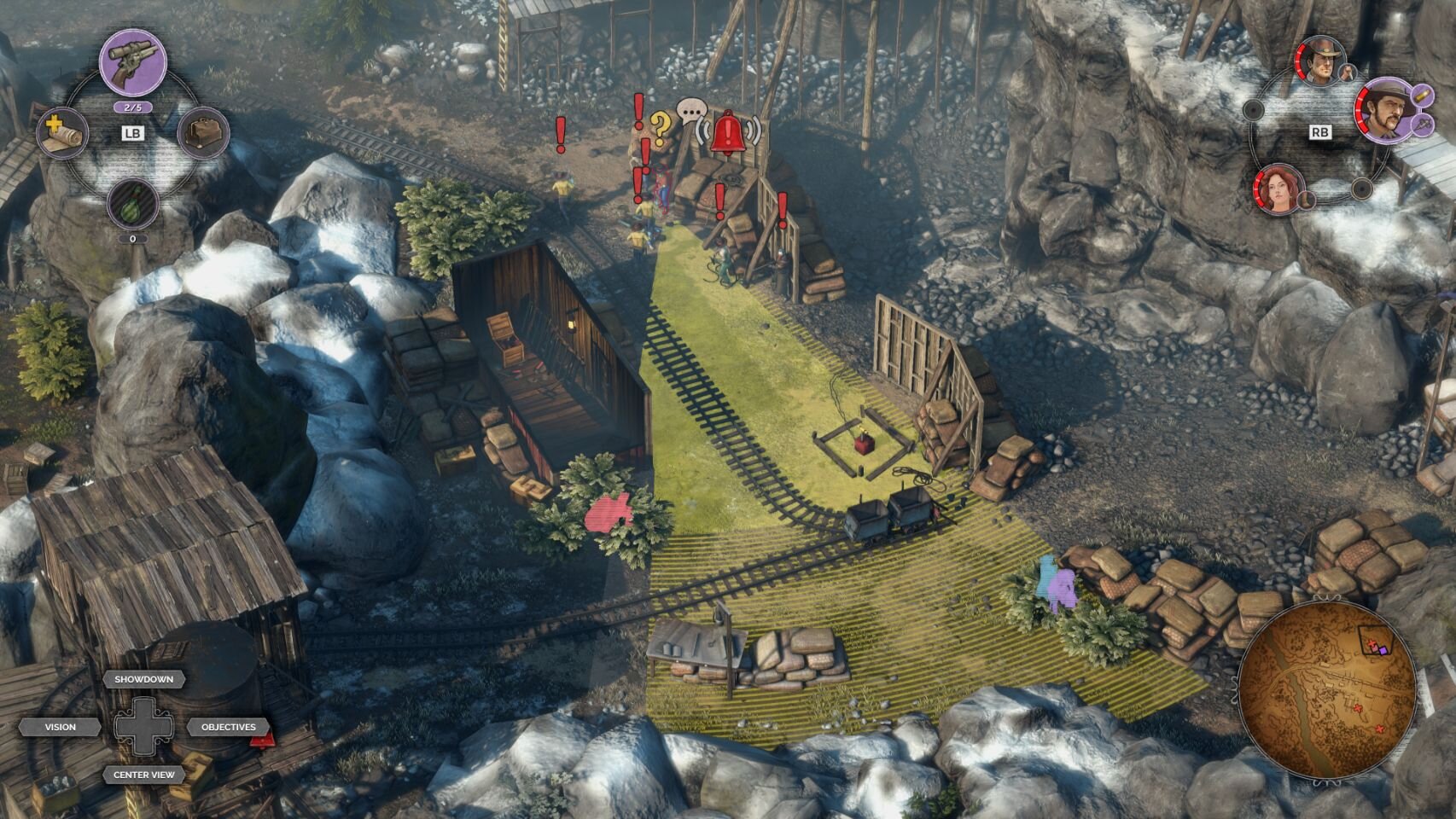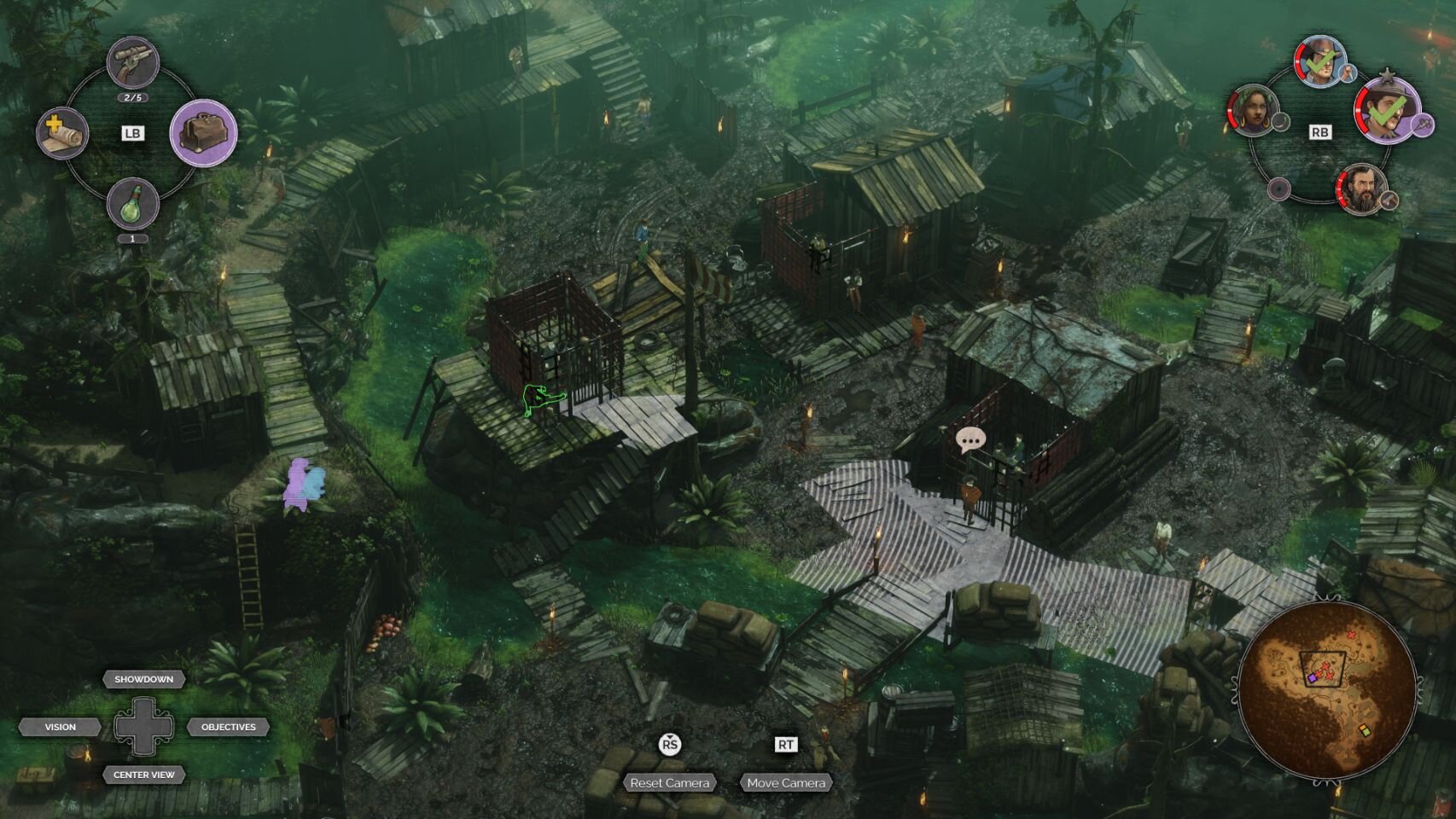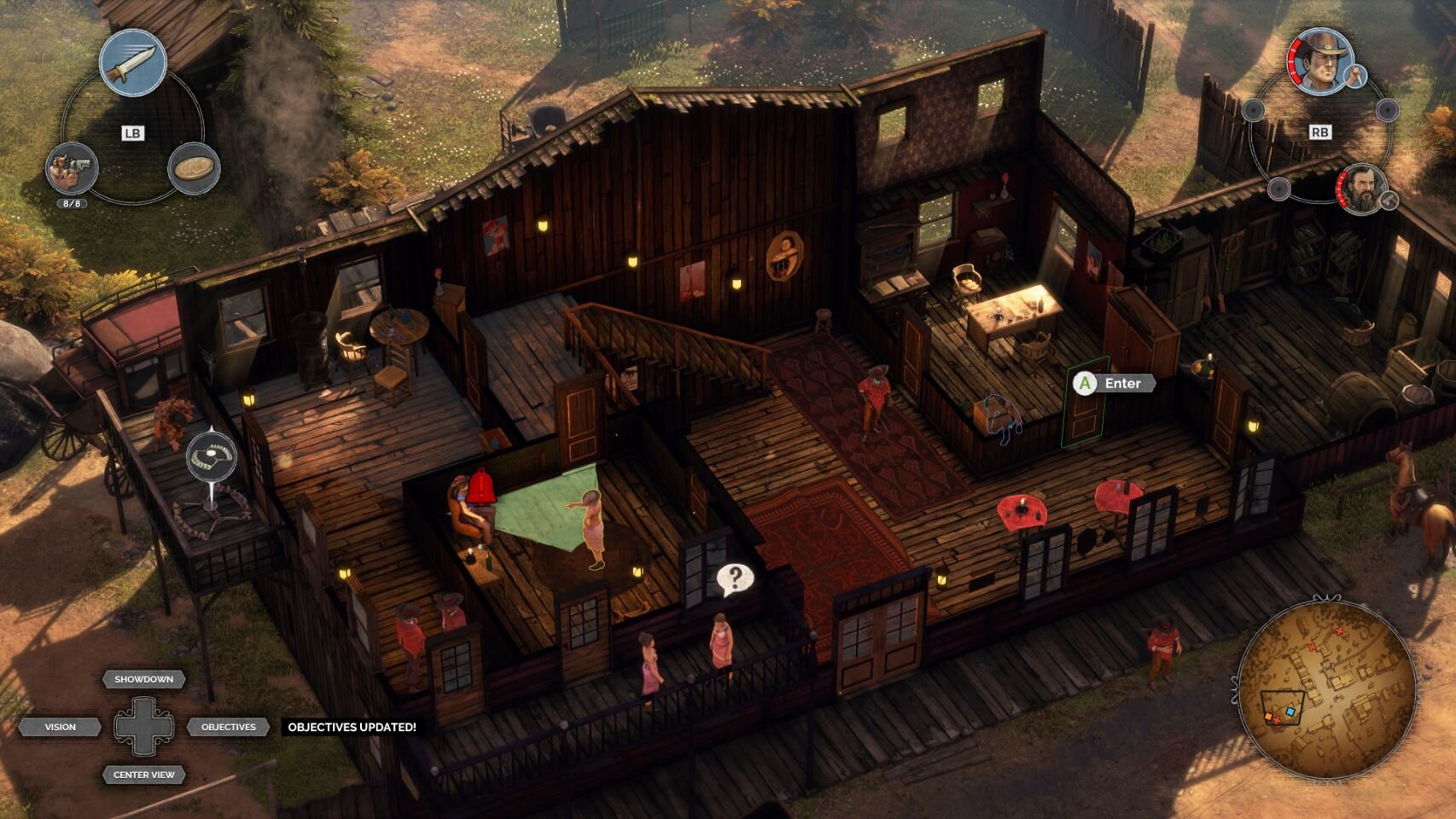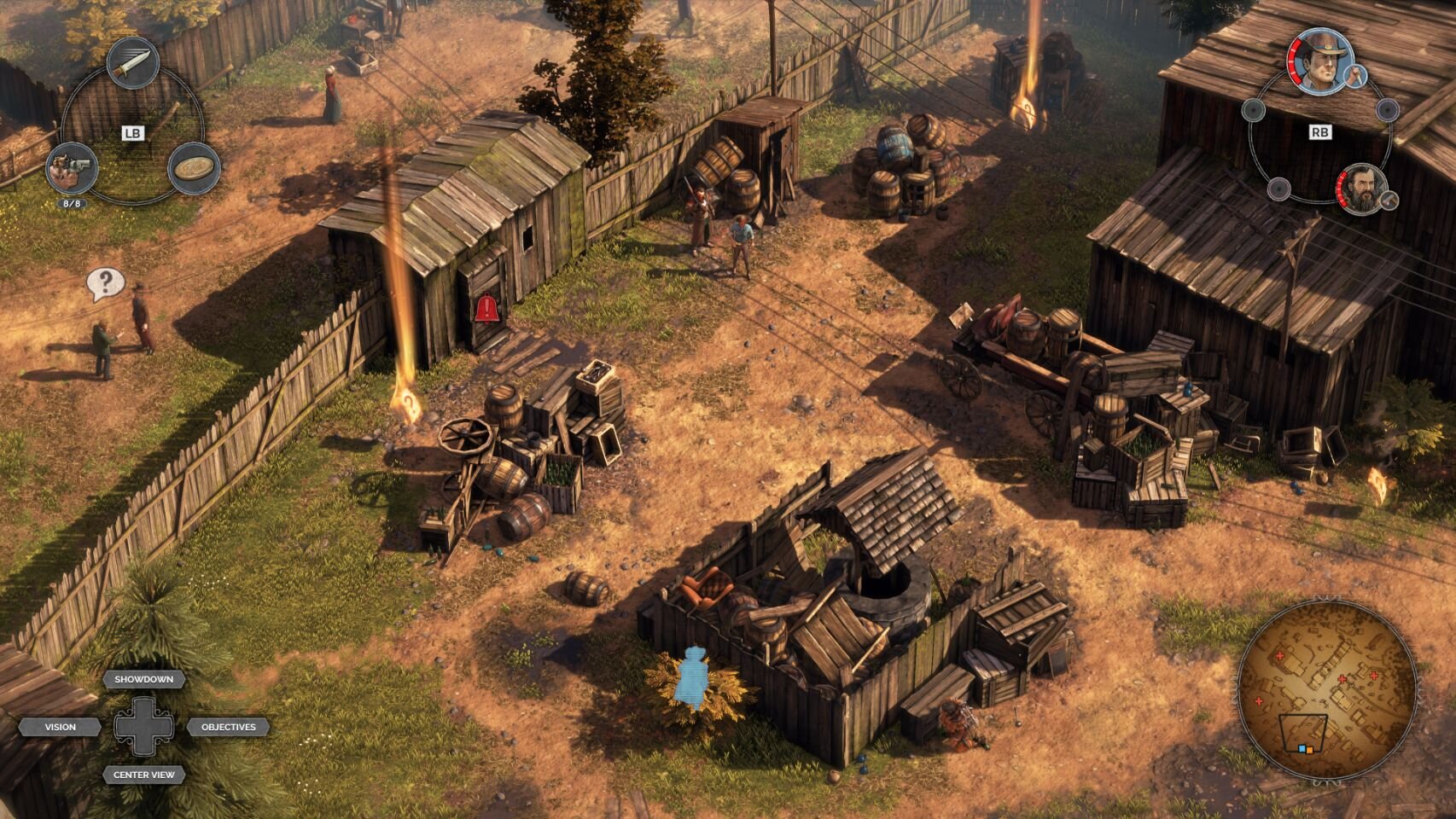If there is one genre that compliments itself to video games almost perfectly, it’s that of a western. Guns everywhere, and everyone itchin’ to use ‘em. The Desperados series first started back in 2001, and for the next following years, it spawned a sequel and a spin-off; Helldorado, but went silent for the next decade. Desperados III, developed by Mimimi Games, the team behind Shadow Tactics: Blades of the Shogun, has brought the series back as a prequel, showing how many of the series’ original characters met. For those that have played Shadow Tactics, the gameplay will feel very familiar, with a few quality of life updates and some new interesting ideas to back them up.
Everything that Desperados III tries to do is largely successful. It has an entertaining story filled with some really remarkable moments, and the planning and execution of being a tactical strategy game is fleshed out with characters of varying skills and capabilities that make several levels have vast replayability as you tinker with new routes, new methods, and treating each set up like a powder-keg sandbox. You’ll do everything from free a blocked train under siege by bandits, defending a farmstead from being taken over, to kidnapping the host of a party as you mingle with the guests, all while you attempt to track down a man that has historic ties with the lead, John Cooper. While strategy and tactical games have never been my cup of tea, I found Desperados III to be really impressive, with a wealth of customizable options to tailor the game’s challenge to what I personally wanted from it.
I’ll also stress that at first, the default control setup wasn’t to my liking and It’s something that I would suggest changing as not only did it make the game far easier to control, but it made encounters and exploration drastically more enjoyable. The default setting is all about the viewing angle of what you’re seeing, as opposed to the character you’re playing. This means that if you want the camera focused on your moving character, you would need to manually reset the focus of the camera on that character after every single change you make to the viewing camera. As you move the right analog stick around, you move the viewing camera, you can also alter the angle by holding RT and then pulling back on the analog stick to adjust the camera or spinning it around to get a better shot at the action. Each of these changes will pull the camera off your selected character and you’ll need to press down on the d-pad to refocus the camera each and every time. This got old fast and frankly, I wasn’t enjoying myself. The game was extremely fun but controlling it was an exercise in frustration. Going into the options allowed me to make my character the focus of the camera at all times. I could then use the right analog stick to pull back or swivel the angle, and holding RT was then used to move the viewing camera around. This was a game-changer and elevated the fun I was having to what I expected from the game in the first place. Honestly, if this wasn’t an option, my score would have been drastically lower.
Taking place in the 1870s, Desperados III is a prequel to the events of the original game, detailing the story of how many of the series’ staple characters met. This makes this third entry very easy for newcomers to come to grips with the relationships between the cast, but also for longtime fans to see how their favorites characters first came together. The story itself is surprisingly great in fact, with some moments that really stand out. While I expected the stealth action to be the star of the show, and frankly, it still is, the narrative of John’s quest is still remarkably superb, with some great vocal performances from the main cast, especially that of Todd Haberkorn’s portrayal of “Doc” McCoy. The narrative starts with John as a boy, learning some in’s and out of the outlaw game by his father, who plays a part in how this story kicks off. What follows is an act of revenge, but also one of the “family” that surrounds John and his mission. We get to know each character rather well, with some brilliantly written banter between them all, giving us a look at how certain relationships within the group work. Not only can the writing be rather personal between the group, but there is also some laugh out loud moments, like when Hector and McCoy start a game of kills, like a certain Dwarf and Elf we all know.
There are times where the group is at odds with aspects of the mission and how John wants to go about it, and these moments are extremely well written and make the team stronger when they overcome it. Every mission is written in a way where you get to know certain things about a character’s past and while there are a few flashbacks, especially one that provided a very shocking revelation, I was pleased when characters would open up and converse with each other about themselves while I hid in the grass to plot my next move. Some missions will actively place certain characters together in a way where it splits up certain members of the group. It was nice to not have the same pairings each time it did this, allowing everyone to get their crack at getting to know someone else. Thankfully, there is almost no repeated dialogue, meaning you are not going to hear the same tired jokes or conversations over and over again. While missions are very up to you on how they play out, the game can feel naturally scripted due to how well-paced the dialogue and narrative moments play out.
At various points in the campaign, you’ll be introduced to characters that will join up alongside you. By Chapter 8, you’ll have everyone as part of your cause, though, some of them may find themselves preoccupied with their own matters and this will alter who you have access to during a few encounters. Your primary protagonist is John Cooper, a man who is set on a path, and it’s not long before the cynically minded Doc McCoy makes an appearance, joining Cooper in a time of need. Largely a gun for hire, he’ll become an asset to not just John, but the whole team. As you make your way to the first town, you’ll run into Hector Mendoza, who has been an ally to John for several years. He’s big, bulky, and can do much of the heavy lifting, not to mention he can cleave some harder to kill enemies in a single strike. Lastly, you have Kate O’Hara and Isabelle Moreau, who each have connections to the man that John is tracking. Kate will meet you on the day of her supposed wedding, while Isabelle will rescue the team in hopes they can lead them to her missing friend.
Each companion, including John, will have various weapons and skills that can solve many scenarios of how guards will be positioned around each environment. While you can go in gun’s blazing, provided you have the ammo to allow for it, Desperados III is primarily a stealth game, and many mechanics and abilities are centered around that very style of play. John can toss a coin to distract nearby enemies or throw a knife at close range right into their skull. Doc McCoy, while packing a far range sniper rifle, has a history with alchemy and thus has a trap set upon a throwable bag that can get the attention of those in its path, or throw a concoction that can daze fairly large groups of enemies, allowing you to go in for the kill. Hector Mendoza lugs around a massive bear trap that can cleave anyone in two, and also packs a hefty double-barrel shotgun and can get the attention of a nearby guard with a quick whistle. Kate is less action-focused and can daze enemies with a perfume vial, or procure costumes to distract guards. She does pack a Derringer, but her usefulness is in luring certain types of guards into areas where you can knock them out, or have another character sneak up behind them and snap their neck. Isabelle Moreau, along with her cat, Stella, can distract guards with her feline friend, or use her mystical voodoo arts to take over the body of someone nearby, or link two souls together, causing harm to befall both parties. She brings a very different energy and pacing to the game in all the right ways.
Desperados III is all about completing objectives and then arriving at a meeting place. By using each character’s abilities and weapons, you’ll combine those into a tactical throughline as you attempt to solve each positional puzzle of ensuring you are not seen or that you’ll leaving bodies out in plain sight. Enemies have a vision cone that can be shortened as they cannot see over or through some objects, giving you just enough wiggle room sometimes to get where you need to go. You’ll leave tracks in the mud, or make a significant noise as you trudge through deep swamp water. There will be parts of each location where you can set up a few deaths to look natural, like pushing a boulder over onto a patrol, cut the rope on some construction, or toss a coin at a horse, having them buck at whoever just happens to be unfortunately standing behind them. There is even a moment midway through the game where you can set off some planted dynamite, blasting half a dozen guards in the process with just a little planning. Each level has various ways to proceed that will require you to think on your feet if you want to dish out the damage yourself or make as many deaths look like an accident as you can.
Each location brings with it a selection of enemy types. There are no real boss encounters here, but rather an assortment of guards that will either move to investigate a noise, remain standing where they need to or require a great deal of punishment to put down, that is if you don’t use Hector to smash their head in with this trusty axe. Each type of enemy is dressed in a way that makes them known; guards in ponchos won’t move from their position, and those in long coats will require that you bring some serious firepower, that, or in the farmstead level, wait until they pass through some tar and then set it on fire. There are a lot of ways you can dispose of them if you can’t get Hector in position to cause some bloody carnage. While you’ll often have or find enough ammo to kill who you need too, it’s best to hide in bushes, small buildings, and ensure that any body you drop is well hidden, or additional back up guards will come out to investigate the scene. Should they not find anything, they will then return back to the building they erupted from.
One feature that Desperados III brings with it is its Showdown mode, allowing you to pause time and think out a strategy. This also allows you to pull off numerous attacks with your whole squad in one go. In fact, there is one moment in the game where you’ll need to dispatch a huge group of enemies with your team, resulting in everyone blasting off their most powerful attack in one go. You can set up characters to traverse to an enemy and slit their throat, all while Doc gets off a long-distance shot at the same time his kill affects another threat that is connected to them via Isabelle’s voodoo magic. It’s a very satisfying thrill when you set up an elaborate kill chain and see it succeed. As you set up your plan, you can execute it with a single button press, or long-press it should you find that it just won’t work. While I didn’t truly rely on it in every encounter, it came in handy several times in some packed locations.
Each mission will take you anywhere from a half-hour to almost two hours, depending on how methodical you get and several of those methods can result in a lot of trial and error. Thankfully, there is a fast quick-save and quick-load that can put you back at the base of an idea and then change it up should it not have worked. Now, that said, while saving and loading in the moment is quick, loading into a new level is drastically long. While levels have a write-up to feed you a bit of the narrative while you wait, some of them can be read from start to finish in less than 10 seconds, making the next almost minute feel far too long. Desperadoes III features 16 missions that should take you around 30 hours to push through, to say nothing of the additional challenges that have you revisit earlier areas to participate in new objectives, especially when you’re bringing in new characters that were not part of those levels before. It gives the game a decent amount of replayability, to say nothing of replaying levels and trying out a different strategy altogether. Each level also has you earning completion badges, such as killing enemies a certain way or trying to solve a whole level without firing off a single shot.
I touched on the controls earlier, but there are a few other things to discuss. Characters can be controlled individually or you can select up to the whole team to follow you. They will mimic what you do, so when you duck they do as well, and if you’ve stopped to hide in a bush, they will follow and do the same. You’ll swap party members by either pressing RB, or by holding it down and selecting them like a weapon wheel. The same is said of your gun’s and abilities as LB will operate the same way as selecting your character. There are also a vast amount of custom settings, difficulties, and various options to tailor the experience of the game to what you want from it. You can change the outline of enemies to stand out far more, or change how fast they can detect you, giving you a few extra precious seconds to escape. Even if you are not a huge fan of the genre, like myself, there are settings available to make the game work for you.
Desperados III is visually impressive and often rather stunning, with a wide range of environments that will keep you on your toes as you try to pinpoint where every single guard is and the best route to take to shut them down. From the mountains of Colorado to the Bayous of New Orleans, all the way to New Mexico, each of the 16 levels offers a pretty massive location to explore and find a path to solve each of its well put together puzzles. You can swivel the camera around or zoom in to check out the staggering detail that has gone into making every level pop and stand out from one other. The voice acting is also impressive as well with only a few occurrences where it can feel somewhat phoned in via its far lesser characters, but otherwise, there is some top-notch talent here that elevates the game greatly.
As fas issues go, there are some animations that feel designed slowly so that there is more tension to getting caught. Picking up and dragging a body can seem a bit too long, and the game can have a few obstacles in the environment that can block or have your character get hung up on, making them get caught a bit unfairly. Each of these issues are pretty minor in the grand scheme of things, and apart from there being a bit too much trial and error built around the game, I honestly don’t have many issues with what the team has done here.
Desperados III is a very engaging game with a surprisingly gripping story of revenge. While the game can have levels of some intense action and firefights, it’s natural fit is one of stealth and keeping to the shadows. Because of this, the pacing can certainly feel different from what other western games have offered in the past, but given this is a stealth-based strategy game, it’s expected to feel a lot slower and intentionally methodical. While it may feel like nothing more of a reskin of what the team did with Shadow Tactics, Developer Mimimi Games has done a lot here to refine its gameplay and given this almost forgotten franchise new life, and frankly, I’m glad they did.
A review code of Desperados III was provided by the publisher for the purpose of this review and played on an Xbox One X.
All screenshots were taken on an Xbox One X.



